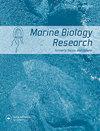菲律宾软珊瑚对2020年白化事件的属和大小特异性敏感性
IF 1.2
4区 生物学
Q4 ECOLOGY
引用次数: 0
摘要
摘要软珊瑚是一种游动的无柄动物,支持珊瑚礁中的各种生物。然而,它们的种群受到海洋变暖影响的威胁。在热应力条件下,软珊瑚可能会经历轻度到重度的白化,这可能导致死亡。了解软珊瑚白化反应突出了预测种群和多样性如何受到气候变化情景影响的重要性。在本研究中,我们检测了三个优势软珊瑚属(Lobophytum = 1318;Sarcophyton,n = 116;Sinularia,n = 639个菌落)在2020年热应力事件期间,在菲律宾西北部潘加南的Bolinao Anda Reef Complex(BARC)的属和菌落大小易感性以及虫黄藻密度方面。1986年至2020年的升温周(DHW)数据是使用遥感数据获得的,以确定研究地点的热异常。2020年的最大DHW(6.3)发生在7月至8月之间,而漂白调查则在同年10月进行。每个菌落中漂白部分的百分比用于确定漂白类别:无漂白(0%)、中度漂白(1-50%)和重度漂白(>50%)。漂白流行率的量化和菌落大小的易感性是通过2020年10月从象限照片中获得的菌落计数和平均直径测量来确定的。触觉组织采集(~3 cm),以量化虫黄藻密度。结果表明,大叶藻菌落的漂白率最低(41%),其次是奇异藻(66%)和Sarcophyton(78%)。三个属的所有菌落大小的类群都易受漂白影响。然而,小叶藻的较小菌落(<15 厘米),Sarcophyton(<5 cm)和奇点(<5 cm)显示出比大菌落更低的易感性。中度和重度漂白菌落中的虫黄藻密度显著降低。这项研究的结果强调,漂白敏感性是属特异性的,Sarcophyton和Sinularia比Lobophytum更容易漂白。与大型软珊瑚相比,较小的珊瑚群落似乎不太容易白化,这表明它们有不同的热应力反应。在不同环境条件和热应力历史的珊瑚礁遗址中,也发现了白化流行率的空间变化。这项工作提供了关于漂白如何影响软珊瑚的初步观察。建议对软珊瑚群落恢复进行进一步研究,以充分了解这些生物在热应力事件后的表现。本文章由计算机程序翻译,如有差异,请以英文原文为准。
Genus and size-specific susceptibility of soft corals to 2020 bleaching event in the Philippines
ABSTRACT Soft corals are zooxanthellate sessile animals supporting various organisms in coral reefs. However, their populations are threatened by the impacts of ocean warming. Under thermal stress conditions, soft corals may experience mild to severe bleaching which may lead to death. Understanding soft coral bleaching responses highlights the importance in predicting how populations and diversity may be affected by changing climate scenarios. In this study, we examined the bleaching responses of the three dominant soft coral genera (Lobophytum, n = 1318; Sarcophyton, n = 116; Sinularia, n = 639 colonies) in the Bolinao-Anda Reef Complex (BARC), Pangasinan, north-western Philippines during the 2020 thermal stress event in terms of genus and colony size susceptibility, and zooxanthellae density. Degree heating week (DHW) data from 1986–2020 were obtained using remotely sensed data to determine thermal anomalies in the study sites. The maximum DHW (6.3) in 2020 occurred between July–August while bleaching surveys were done during October of the same year. The percentage of bleached portions in each colony was used to determine bleaching category: no bleaching (0%), moderately bleached (1–50%) and heavily bleached (>50%). Quantification of bleaching prevalence and susceptibility of colony sizes were determined by colony count and mean diameter measurements taken from quadrat photographs in October 2020. Haphazard tissue collection (∼3 cm) in each colony of three soft coral genera per bleaching category was done to quantify zooxanthellae density. Results showed that Lobophytum colonies had the lowest bleaching prevalence (41%), followed by Sinularia (66%) and Sarcophyton (78%). All colony size classes of the three genera were susceptible to bleaching. However, smaller colonies of Lobophytum (<15 cm), Sarcophyton (<5 cm) and Sinularia (<5 cm) showed less susceptibility than large colonies. Zooxanthellae density was significantly reduced in moderately and heavily bleached colonies. The results of this study highlight that bleaching susceptibility is genus specific, with Sarcophyton and Sinularia being more susceptible to bleaching than Lobophytum. Smaller colonies seemed to be less susceptible to bleaching than large-sized soft corals suggesting a differential thermal stress response. Spatial variations in bleaching prevalence were also found among reef sites with varying environmental conditions and thermal stress histories. This work provided initial observations on how bleaching affects soft corals. Further studies on soft coral community recovery are recommended to fully understand how these organisms perform after thermal stress events.
求助全文
通过发布文献求助,成功后即可免费获取论文全文。
去求助
来源期刊

Marine Biology Research
生物-海洋与淡水生物学
CiteScore
2.10
自引率
0.00%
发文量
55
审稿时长
6-12 weeks
期刊介绍:
Marine Biology Research (MBRJ) provides a worldwide forum for key information, ideas and discussion on all areas of marine biology and biological oceanography. Founded in 2005 as a merger of two Scandinavian journals, Sarsia and Ophelia, MBRJ is based today at the Institute of Marine Research, Bergen, Norway. The Journal’s scope encompasses basic and applied research from all oceans and marine habitats and on all marine organisms, the main criterium for acceptance being quality.
 求助内容:
求助内容: 应助结果提醒方式:
应助结果提醒方式:


